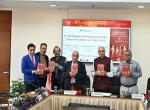Vivekananda International Foundation organized a webinar on 17 December 2020 on Philosophy of the Upanishads by distinguished speaker, Prof. Shashi Prabha Kumar, Dean, Sri Sankaracharya Sanskrit Mahavidyalaya, Bhartiya Vidya Bhavan. This lecture is part of the VIF lecture series ‘Philosophy for Beginners’. The webinar began with the opening remarks by Dr. Arvind Gupta, Director, VIF, where he mentioned about the previous insightful lecture on the Introduction to the Vedic Literature given by Prof Kumar.
Introduction to Upanishads
Prof. Shashi Prabha Kumar began the lecture by reciting an invocation from the Upanishads. She mentioned about the significance of the invocation: praying for the mutual learning of the teacher and the taught. Mentioning about her previous lecture on the Introduction to Vedic Literature, Prof. Kumar reiterated that there are eleven principal Upanishads. She added that each of these Upanishads is associated with one of the four Vedic Samhitas. Furthermore, they are widely known as principal Upanishads as Adi Shankaracharya wrote commentaries on them. She mentioned the names of eleven principal Upanishads: Isha, Kena, Katha, Prasna, Mundaka Maṇḍukya, Aitareya, Taittiriya, Chandogya, Brihadaranyaka and Shvetashvatara (there is some debate though if the commentary on the Shvetashvatara Upanishad attributed to Adi Sankara is indeed his).
Symbolic Meaning of Upanishads
Prof. Kumar explained the derivation of the word “Upanishad”. The word Upanishad can be broken down into upa, ni, and shad, where upa means near, ni means sitting down and shad means sitting. Symbolically, upa denotes closeness, ni denotes humility towards the teacher, and shad denotes consistency. Hence, Upanishad translates to the process of consistent learning in close proximity with the teacher. After deciphering the meaning of the word Upanishad, she explained what Upanishads are in Vedic literature. The Upanishads are dialogues or a series of questions and answers between a seeker and a seer. These conversations are methods to acquire the knowledge of the self, often termed as Atman or Brahman in the Upanishads. After emphasizing upon the spiritual nature of Vedic knowledge, Prof. Kumar defined seer as a person who has realized the absolute truth of Self or the Atman, and seeker as a person who is extremely sincere to know the ultimate truth. She explained that Upanishads collate the knowledge of the self. This knowledge is known by various names such as Atma vidya, Brahma vidya or Adhaytma vidya. A seeker of this knowledge needs to be humble, committed, patient and at peace with himself.

The Three Sub-divisions in the Philosophy of Upanishads
Metaphysics
Moving further, Prof. Kumar mentioned that the philosophy of the Upanishads is taught under three broad heads: Metaphysics, Epistemology and Ethics. Metaphysics is associated with the nature of reality. She elucidated the question posed in the Mundaka Upanishad, “What is that by knowing which everything else will be known?” Under Metaphysics, the Upanishads impart the knowledge of the self and the absolute reality around us. Hence, Metaphysics covers the knowledge and essence of the Atman and Brahman. The Atman and Brahman are not different or segregated in Upanishads but are treated as one, said Prof. Kumar.
Epistemology
The second part of the philosophy of the Upanishads is Epistemology. Epistemology of Upanishads includes the ways of knowing the Atman and Brahman. It bestows the means of realizing the ultimate reality and truth. Prof. Kumar mentioned that there are three methods prescribed in the Upanishads to realize the ultimate reality or the self: Shravana (listening), Manana (contemplation), and Nididhyasana (concentration).While the means of knowing are the sense organs of the human body, the content of the Upanishads transcends them, said Prof. Kumar. To explain further, she quoted the question from the Kena Upanishad, “Who is that, who impels or motivates or activates our sense organs?” After posing the question, she emphasized upon the significance of manana or contemplation in daily life. She elucidated that the Upanishads try to decipher the force behind the actions; however, they signify the limitation of human organs to perceive the force behind their functioning. She suggested that a seeker must practice shravana, manana, and nididhyasana collectively to perceive the content of the Upanishads. One can realize the essence of truth by listening to a person, who has realized it, suggested Prof Kumar. She also mentioned that one has to ponder over and concentrate on the reality around us to realize the truth.
Ethics
The third part of the philosophy of the Upanishads is Ethics. Ethics include the attributes of the seeker. A seeker must be humble and morally sound, emphasized Prof Kumar. Additionally, the seeker must stay in close proximity with the teacher and practice strict discipline, away from the comforts of home. The moral attributes that a seeker must exhibit are satya (truth), tapa (austerity), shraddha (faith), dama (self-control), dana (generosity), daya (compassion) and brahmacharya (celibacy), mentioned Prof Kumar. Hence, a seeker is termed a satyanvesi in the Upanishads, denoting an attendant or pupil living with the teacher, said Prof. Kumar.
The Translation of the Upanishads
After the Bhagvad Gita, Upanishads are the most translated texts. Since the 16th century the original Upanishads have been translated from Sanskrit to various languages. Explaining the significance of the Upanishads, Prof. Kumar quoted the celebrated German philosopher Arthur Schopenhauer,
“From every sentence, deep original and sublime thoughts arise and a whole is pervaded by the high and holy, earnest spade. In the whole world there’s no study so beneficial and so elevating as that of the Upanishads. It has been the solace of my life and it will be the solace of my death.”
Moving further she said, Arthur Schopenhauer received the Latin translation of the original Upanishads. The first translation of Upanishads from Sanskrit to Persian was made in the 17th century by Dara Shikoh, said Prof. Kumar. Dara Shikoh translated Upanishads as a collection of fifty original texts. His translation is prominently knows as Sirr-e-Akbar. The Sirr-e-Akbar was sent to Europe during the East India Company’s reign in India. Later, a French scholar Anquetil-Duperron, an officer in the East India Company received the copy of Sirr-e-Akbar. He translated the Upanishads’ Persian translation, the Sirr-e-Akbar into Latin in the 18th century, and the translation was published as Oupnek’hat in early 19th century. Arthur Schopenhauer received this Latin translation of the Upanishads. Anquetil Duperron also translated the Upanishads from Latin to French and German, said Prof Kumar. She mentioned that Radhakrishnan and Raja Ram Mohan Roy translated the Upanishads into English. Max Mueller also made major contribution to the English translations, said Professor Kumar. She added that Radhakrishnan called the Upanishads a world scripture in a global conference of scholars.
Famous Allegories in the Upanishads
Prof. Kumar mentioned one of the most compelling dialogues from the Upanishads that took place between Nachiketa and Yama, the Hindu deity of death in the Kaṭhopanishad. She explained that Nachiketa was a young seeker who went to Yama, the seer. Further, she mentioned that Nachiketa questions Yama on life after death. He asks Yama, “Is there anything that remains after death?” After refusing the lucrative materials and comforts Yama promised in lieu of answer to his question, Nachiketa insisted, “O Yama, I know nothing lasts after death. Please tell me is there anything that remains after death?” Moving forward, the speaker highlighted that Yama was forced to deliver his knowledge to the young seeker after seeing his tremendous patience and purity.
Other famous dialogues mentioned by Professor Kumar were between Yajnavalkya and Maitrayee, and the dialogue between Prajapati and the devas (divine beings), manavas (human beings), and danavas (evil beings). Each of these dialogues signifies the essence of the supreme and the path to immortality. Moving further, Professor Kumar, mentioned about the allegory of the chariot from the Bhagvad Gita. She explained that the chariot is the body and the charioteer is the Atman or Brahman. Furthermore, she elucidated that sarathi (one who drives the chariot) signifies the buddhi (higher form of intellect) that guides the body. She suggested that the philosophy of the Upanishads is holistic in nature, where the seeker seeks to understand the real nature of the body and of Atman to realize the truth.
Food as the Beginning of Spiritual Journey
The philosophy of the Upanishads includes the Pancha Kosha theory mentioned in the Taittiriya Upanishad. Professor Kumar mentioned about the Pancha Kosha theory and suggested that the Philosophy of the Upanishads is holistic in nature. The five sheaths begin with the sheath of food or anna called the Annamaya kosha. The food we intake is the most gross material. She mentioned that the Taittiriya Upanishad gives us knowledge on the various foods that one should partake of. One should grow a variety of cereals. The food taken by the human body reflects upon our thoughts and affects our mind, said Professor Kumar. Thus, anna is necessary for sustaining a healthy body and mind. Hence, the first step to spiritual journey is the intake of proper and healthy food. She then discussed the other four sheaths, namely, the pranamaya, manomaya, vijnanamaya and anandamayakoshas and what they represent.
The Philosophy of the Omkar
The most important aspect of the philosophy of the Upanishads is the Omkar or Om, emphasized Prof. Kumar. She added that it is the most subtle and significant appellation of the ultimate reality. She said that the Mundaka Upanishad explains what the Omkar is. A-kar, U-kar and M-kar signify the different stages of consciousness, suggested Prof. Kumar. The different stages of consciousness culminate into the ultimate reality and happiness.
Closing Remarks and Q&A Session
At the end of the session, Dr. Arvind Gupta, Director VIF, appreciated how effortlessly Prof. Kumar explained the various aspects of the philosophy of the Upanishads. Furthermore, he stressed upon the role of the seeker and seer of knowledge in the process of learning. In addition to that, he emphasized upon the significance of food in the spiritual journey. He insisted that the knowledge of the Upanishads should be imparted to children at home, and colleagues at workplace. This will make us better human beings, said Dr. Gupta.
The closing of session was followed by many questions from the attendees. Prof. Kumar answered the questions emphasizing upon the issue of way of life. In the end of the session, she highlighted the difference between temporary happiness and long lasting bliss.







Post new comment